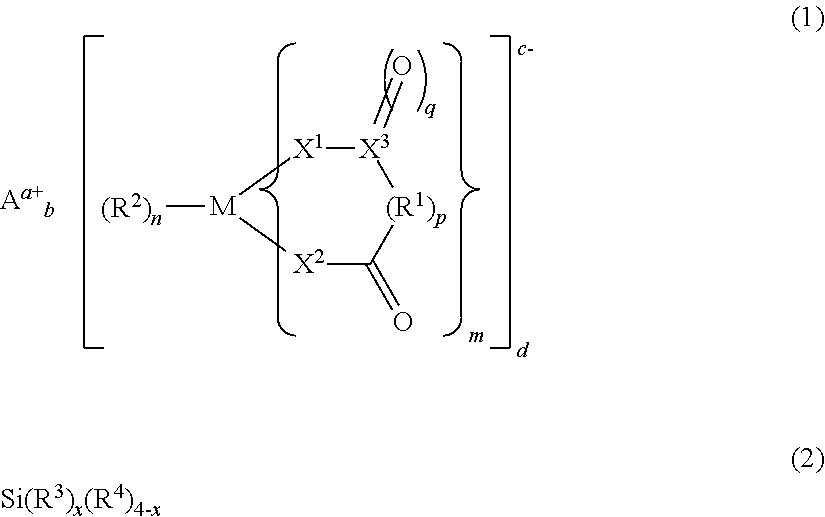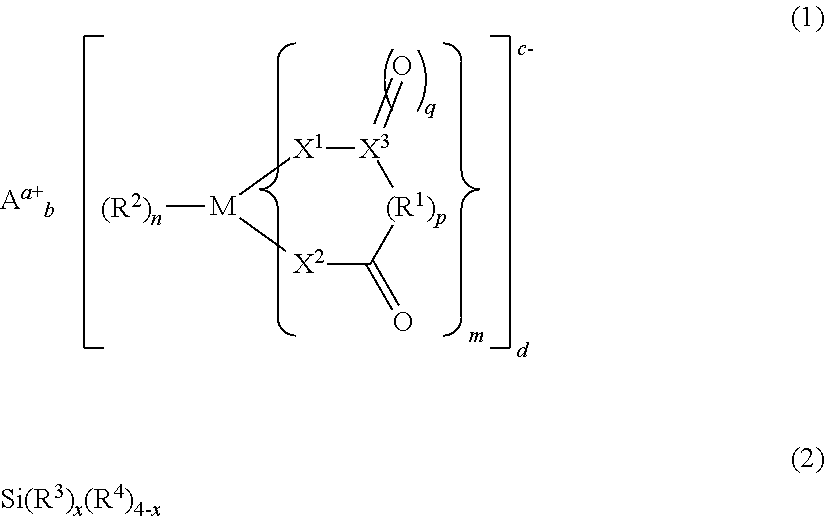Electrolyte solution for non-aqueous electrolytic solution battery and non-aqueous electrolyte solution battery using same
a technology of electrolyte solution and electrolyte, which is applied in the direction of electrochemical generators, electrical apparatus, organic electrolytes, etc., can solve the problems of non-aqueous electrolyte solution batteries greatly degraded, unsatisfactory durability for various applications, etc., and achieve excellent high-temperature storage characteristics, excellent high-temperature cycle characteristics
- Summary
- Abstract
- Description
- Claims
- Application Information
AI Technical Summary
Benefits of technology
Problems solved by technology
Method used
Image
Examples
example 1-1
[0072]A cell was fabricated by using Electrolyte Solution No. 1 as a non-aqueous electrolyte solution, LiCoO2 as a positive electrode material, and graphite as a negative electrode material, and the battery was actually evaluated for high-temperature cycle characteristics and high-temperature storage characteristics. The test cell was fabricated as follows.
[0073]A paste was obtained by mixing 90% by mass of LiCoO2 powder with 5% by mass of polyvinylidene fluoride (PVDF) as a binder and 5% by mass of acetylene black as a conductive material, and further adding N-methylpyrrolidone. This paste was applied onto aluminum foil, and dried. Thus, a positive electrode member for test was obtained. Meanwhile, a slurry was obtained by mixing 90% by mass of graphite powder with 10% by mass of polyvinylidene fluoride (PVDF) as a binder, and further adding N-methylpyrrolidone thereto. This slurry was applied onto copper foil, and dried at 150° C. for 12 hours. Thus, a negative electrode member fo...
examples 1-2 to 1-64
and Comparative Examples 1-1 to 1-16
[0078]Cells which were the same as that in Example 1-1 were each fabricated by using the corresponding one of Electrolyte Solutions No. 2 to 80 instead of Electrolyte Solution No. 1, and the high-temperature cycle characteristics and the high-temperature storage characteristics were evaluated in the same manner. Table 2 shows the evaluation results.
[0079]
TABLE 1First compoundSecond compoundConc.Comp.Conc.Name of compound(% by mass)No.(% by mass)Electrolyte Solution No. 1Lithium1.0No. 10.01Electrolyte Solution No. 2difluorobis(oxalato)phosphate1.00.05Electrolyte Solution No. 31.00.1Electrolyte Solution No. 41.00.5Electrolyte Solution No. 51.01.0Electrolyte Solution No. 61.02.0Electrolyte Solution No. 71.03.0Electrolyte Solution No. 81.05.0Electrolyte Solution No. 91.06.0Electrolyte Solution No. 100.10.5Electrolyte Solution No. 110.50.5Electrolyte Solution No. 122.00.5Electrolyte Solution No. 133.00.5Electrolyte Solution No. 144.00.5Electrolyte Solu...
examples 2-1 to 2-15
and Comparative Examples 2-1 to 2-9
[0093]In Examples 2-1 to 2-15 and Comparative Examples 2-1 to 2-9, batteries were evaluated by preparing electrolyte solutions for non-aqueous electrolyte solution batteries and fabricating cells in the same manner as in Example 1-1, except that the negative electrode member and the electrolyte solution were changed as shown in Table 4. Note that, in Examples 2-1 to 2-5 and Comparative Examples 2-1 to 2-3, in which the negative electrode active material was Li4Ti5O12, each negative electrode member was fabricated by mixing 90% by mass of Li4Ti5O12 powder with 5% by mass of polyvinylidene fluoride (PVDF) as a binder and 5% by mass of acetylene black as an electrically conductive agent, further adding N-methylpyrrolidone thereto, and applying the obtained paste onto copper foil, followed by drying, and a final charge voltage of 2.7 V and a final discharge voltage of 1.5 V were employed for the battery evaluation. Meanwhile, in Examples 2-6 to 2-10 an...
PUM
| Property | Measurement | Unit |
|---|---|---|
| temperature | aaaaa | aaaaa |
| temperature | aaaaa | aaaaa |
| temperature | aaaaa | aaaaa |
Abstract
Description
Claims
Application Information
 Login to View More
Login to View More - R&D
- Intellectual Property
- Life Sciences
- Materials
- Tech Scout
- Unparalleled Data Quality
- Higher Quality Content
- 60% Fewer Hallucinations
Browse by: Latest US Patents, China's latest patents, Technical Efficacy Thesaurus, Application Domain, Technology Topic, Popular Technical Reports.
© 2025 PatSnap. All rights reserved.Legal|Privacy policy|Modern Slavery Act Transparency Statement|Sitemap|About US| Contact US: help@patsnap.com



